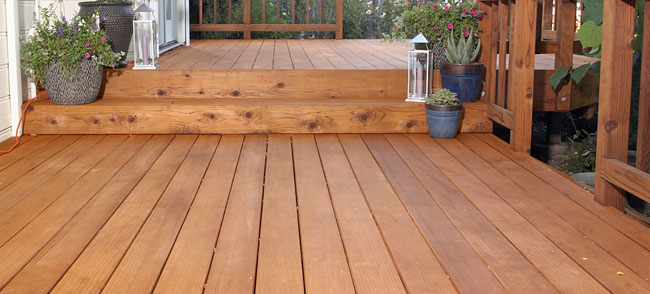Your Deck: Paint or Stain??
One of the most common questions for those who have decks attached to their homes is whether they should paint or stain the deck. There are a number of factors that should be taken into consideration when you make this decision. In this article, we can discuss these and help you understand what works best for different situations.
Decks are extremely vulnerable to the elements. Because they are usually horizontal slats, water can collect and cause rotting and decay. Decks are subject to the direct rays of sunlight. This constant bombardment of the elements can speed up the process of cracking and drying and splintering of the wood used to build the deck. Even decks built with pre-treated wood are not immune to the constant effects of nature. Decks built with pre-treated wood are more able to withstand termites and decay but they still should be treated with some type of good sealer to help prevent long term damage.
Along with keeping your deck safe from the elements, your decision on what to use as a protective covering can also determine how your deck will look. The choice of a clear sealer or a colored stain is an aesthetic one you will need to make based on how you would like your deck to look. A clear sealer will preserve the natural coloration of some of the more common woods used to build decks like redwood, cedar, and cypress.
Using a coating application on your deck is most common when pressure treated wood has been used to build the deck. Most pressure treated wood has a greenish tint and using a coating can cover the tint giving your deck the look you desire and the look that matches your home and landscaping. Both a sealer and a coating can be used but you should ensure that the sealer is applied well before you do use any coating. You should also give the seller ample time to soak in and dry before coating the deck.
If you decide that painting is the route to go when it comes to suiting your deck design flavor you should remember that is essential that you apply two coats of primer before you begin painting. You also should make sure that the primer you use is a good quality exterior primer that can stand the rigors that Mother Nature will throw its way. Use a roller or paint brush to apply your primer so that the primer will actually penetrate the wood rather than simply lying on the surface. Be sure the first coat is completely dry before applying the second and that both coats of primer are dry before painting. Choose a paint that is designed for porches as they are designed to deal with the traffic that will come their way.
Staining is the more common approach when it comes to decks as many homeowners, (myself included) prefer to enhance the natural look of the wood rather than hide it beneath layers of color. If you choose to stain your deck you should take extra care that you have pressure washed your deck and removed dead fibers, dirt, and any mildew spots that may be present before beginning to stain the wood.
Staining will work to protect your deck from not only the damage that can be brought on by rain and standing water but also the damage the sun can bring through UV rays. Staining your decks does require some degree of maintenance and your decks will probably need to be reassessed every 2-4 years in order to ensure the maximum protection for your deck.
Sealers and coatings can be applied with a number of tools. You can use brushes, paint brooms, rollers, and sprayers. In the case of a sealer, the best tool to use would be a brush because you are able to ensure you get a complete coat on your deck and the brush will help ensure any pores are filled as well. For a coating, the best tool to use would be a roller. With a roller, you can ensure a nice even coating without leaving brush strokes or marks in the paint.
Should your deck only need a sealer, you can use a sprayer each year to lightly recoat the deck with to recover high traffic areas and areas where the elements may have caused more exposure. Because your first initial coating was generously applied with a brush, you would not get any additional soaking of the wood so using a sprayer would be sufficient to recover most areas.
There is one other advantage of using a sealer as well. Sealers can help protect your deck against wear and tear on the wood surface directly. Sealers can also prevent many scuff marks from shoes and chairs and tables. Sealers will also help keep other liquids that may be spilled on your deck from soaking into the wood and causing further damage.
By following these simple guidelines you will ensure the beauty and use of your deck for years to come and can avoid expensive and time-consuming repairs. Until next time…Happy Gardening!!

